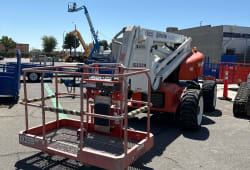Pole Barn Construction: Details, Costs, and Step-by-Step Guide
5 Min read
)
April 6, 2025
Pole barn construction has become one of the most popular methods for building cost-effective, durable structures. Whether you need a storage building, workshop, garage, or agricultural barn, pole barns offer an efficient and flexible solution.
This guide will walk you through pole barn construction details, cost estimates, and a step-by-step building process to help you plan your project effectively.
What Is Pole Barn Construction?
A pole barn is a post-frame building that uses large poles (or posts) as the primary structural support. Unlike traditional construction methods that rely on a foundation and extensive framing, pole barns offer:
Faster construction time
Lower material costs
Versatility for various uses
Common Uses for Pole Barns
✅ Agricultural storage (equipment, livestock, hay)
✅ Residential garages and workshops
✅ Commercial storage and office buildings
✅ Recreational spaces (gyms, event centers)
Pole Barn Construction Details: Key Components & Building Process
1. Site Preparation
Choose a level, well-drained site to prevent flooding.
Mark out the building footprint and clear any obstructions.
Consider adding a gravel or concrete base for stability.
2. Structural Components
A. Posts & Framing
Posts are typically made of treated wood, steel, or laminated columns.
They are set 3-6 feet deep in concrete footings for stability.
B. Trusses & Roofing
Trusses support the roof and are spaced 6-10 feet apart.
Common roofing materials: metal panels, asphalt shingles.
C. Siding & Insulation
Choose from metal, wood, or vinyl siding for durability.
Insulation options: spray foam, fiberglass batts, rigid foam panels.
D. Doors & Windows
Standard options: sliding barn doors, overhead garage doors, or walk-in doors.
Windows improve ventilation and natural lighting.
3. Step-by-Step Pole Barn Construction Process
Set the Posts – Dig post holes, place treated posts, and secure with concrete.
Install Girts & Framing – Attach horizontal supports (girts) to connect posts.
Add Trusses & Roofing – Install trusses and secure metal roofing sheets.
Install Siding & Insulation – Attach exterior walls and insulation as needed.
Add Doors & Windows – Finalize openings for accessibility.
Finish Interior – Add flooring, electrical, and optional plumbing.
Pole Barn Construction Cost: Budget Breakdown
:format(webp))
A. Factors Affecting Cost
Size of the building (small vs. large-scale projects).
Material selection (wood vs. metal frame).
Labor costs (DIY vs. hiring a contractor).
Foundation type (concrete slab vs. dirt floor).
B. Estimated Cost Per Square Foot
C. Additional Cost Considerations
Customizations – Adding doors, windows, insulation, and electricity increases costs.
Permits & Fees – Check local building codes for zoning and permit requirements.
Site Preparation – Grading and foundation work may add to the budget.
How to Reduce Pole Barn Construction Costs
1. DIY vs. Hiring a Contractor
DIY construction can save up to 30% on labor costs.
Professional contractors ensure higher quality but come at a higher cost.
2. Choosing Budget-Friendly Materials
Use galvanized steel siding instead of wood for longevity.
Opt for gravel floors instead of concrete to save on foundation costs.
3. Buying Materials in Bulk
Purchase lumber, metal panels, and fasteners from wholesalers to get discounts.
Pole Barn Insulation and Weatherproofing
Spray foam insulation provides superior air sealing but costs more.
Fiberglass insulation is affordable but requires vapor barriers.
Roof overhangs and gutters help prevent water damage.
Sealing doors and windows improves energy efficiency.
Common Mistakes to Avoid in Pole Barn Construction
🚫 Skipping Site Preparation – Leads to drainage issues.
🚫 Using Untreated Posts – Can cause rotting and structural failure.
🚫 Underestimating Material Needs – Causes delays and extra costs.
🚫 Ignoring Building Permits – Can result in fines or demolition orders.
Conclusion: Is a Pole Barn Right for You?
Pole barn construction is a cost-effective, flexible, and durable building solution for various needs. By understanding pole barn construction details and cost factors, you can make informed decisions to build a structure that meets your budget and long-term requirements.
Ready to Build Your Pole Barn?
✅ Compare material costs and get quotes.
✅ Check local building codes and permits.
✅ Decide whether to DIY or hire a contractor.
Frequently Asked Questions (FAQs)
1. How much does it cost to build a pole barn?
The cost varies based on size and materials, but on average, expect to pay $15 to $35 per square foot.
2. What is the best foundation for a pole barn?
A concrete slab provides the most stability, but a gravel base is a budget-friendly alternative.
3. Can I build a pole barn myself?
Yes! Many homeowners choose to DIY their pole barn with pre-made kits to save money.
4. How long does pole barn construction take?
A small pole barn can be completed in a few weeks, while larger barns take several months.
5. What is the best insulation for a pole barn?
Spray foam insulation is the most efficient but costly, while fiberglass batt insulation is an affordable option.
Start Your Pole Barn Project Today!
With careful planning and cost considerations, you can successfully build a pole barn that meets your needs. Whether it's for storage, business, or personal use, the right construction approach ensures long-term durability and efficiency!

Caleb Woods is an experienced content specialist and an editor at Boom & Bucket, blending his journalism background with expertise in the heavy equipment industry. He delivers engaging, informative content to help professionals stay informed and make smarter decisions in the machinery market.











